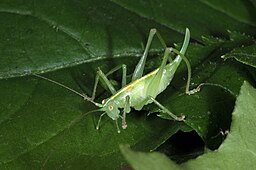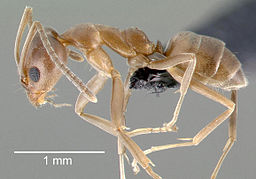 |
n/a | Status LU: established. 1st record: 2003 (?) |
 |
Schäin-Akazi-Minnematt | Status Eur.: established. |
 |
n/a | RA: ISEIA: C3. Harmonia+: n/a. |
 |
Robinienminiermotte | Wikipedia:  | Wikispecies: n/a (2020) | Wikispecies: n/a (2020) |
 |
Acaciavouwmot | Back to the list of invertebrates |
Contents
Brief description
 Phyllonorycter robiniella Clemens, 1859 is a moth of the family Gracillariidae. It is native to North America (where it is distributed from Ontario south to South Carolina and west to Missouri and Texas), but is an introduced species in Europe, where it was first reported near Basel, Switzerland, in 1983. Later, it was also reported in France, Germany, northern Italy (1988), Austria (1989), and Slovakia (1992). It spread gradually through Austria, reaching Hungary in the mid 1990s. The larvae feed on Robinia pseudoacacia, Robinia viscosa and Robinia hispida. They mine the leaves of their host plant (Wikipedia contributors 2020).
Phyllonorycter robiniella Clemens, 1859 is a moth of the family Gracillariidae. It is native to North America (where it is distributed from Ontario south to South Carolina and west to Missouri and Texas), but is an introduced species in Europe, where it was first reported near Basel, Switzerland, in 1983. Later, it was also reported in France, Germany, northern Italy (1988), Austria (1989), and Slovakia (1992). It spread gradually through Austria, reaching Hungary in the mid 1990s. The larvae feed on Robinia pseudoacacia, Robinia viscosa and Robinia hispida. They mine the leaves of their host plant (Wikipedia contributors 2020).
Status and distribution in Luxembourg
Records of Phyllonorycter robiniella Clemens, 1859 in Luxembourg. Data source: Recorder-Lux, iNaturalist & GBIF, 2025-12-20.
“This species is native to North America and was introduced into Europe. It was first identified in 1983 in Basel, Switzerland (Huemer et al. 1992). Since then it has colonized all countries of Central and Western Europe, and in Luxembourg the species can be found everywhere on Robinias. Since 2003 it has been found in several places in Luxembourg (N. Schneider, pers. comm.). In the past it has been reported from Wintringen (Schneider 2004), from Bonneweg and Düdelingen (Schneider & Walisch 2009), as well as from Remerschen, Esch/Alzette and Luxembourg-Kirchberg (Ries 2016). The caterpillar lays conspicuous white blanks on the underside of the leaves of Robinia (Robinia pseudoacacia)” (Hellers 2017: 140-141).
4 observations are documented in the mdata.mnhn.lu portal (MNHNL, iNaturalist & GBIF, 2020).
Risk assessment
ISEIA protocol
C3 (3+1+1+1) (Ries et al. 2017: 69).
Harmonia+ protocol
Not assessed yet.
Worldwide distribution

GBIF, 2019: https://www.gbif.org/species/1749886
Bibliography
- GBIF, 2020. Phyllonorycter robiniella Clemens, 1859 in GBIF Secretariat (2019). GBIF Backbone Taxonomy. Checklist dataset https://www.gbif.org/species/1749886 [accessed 2020-04-10]
- Hellers M., 2017. Die Kleinschmetterlinge Luxemburgs: die Familien Roeslerstammiidae, Douglasiidae, Bucculatricidae und Gracillariidae (Lepidoptera: Gracillariiidea). Bull. Soc. Nat. luxemb. 119: 129-144. [PDF 5,21 MB]
- MNHNL, iNaturalist & GBIF, 2020. Phyllonorycter robiniella Clemens, 1859 in MNHNL-mdata, online portal combining species observation from Recorder-Lux, iNaturalist and GBIF. National Museum of Natural History, Luxembourg. URL: https://mdata.mnhn.lu [accessed 2020-04-10]
- Ries, C., A. Arendt, C. Braunert, S. Christian, A. Dohet, A. Frantz, G. Geimer, M. Hellers, J. A. Massard, X. Mestdagh, R. Proess, N. Schneider & M. Pfeiffenschneider, 2017. Environmental impact assessment and black, watch and alert list classification after the ISEIA Protocol of invertebrates in Luxembourg. Bull. Soc. Nat. luxemb. 119: 63-70. [PDF 360 KB]
- Ries, C. & M. Pfeiffenschneider (Eds.), 2016. Phyllonorycter robiniella Clemens, 1859. In: neobiota.lu – Invasive Alien Species in Luxembourg. National Museum of Natural History, Luxembourg. URL: https://neobiota.lu/phyllonorycter-robiniella/ [Accessed 2016-12-31].
- Schneider, N., 2004. Auf Spurensuche. 24. Raupenspuren. Regulus 9/04: 20.
- Schneider, N. & T. Walisch, 2009 . Sur la présence au Luxembourg d’Obolodiplosis robiniae (Haldeman, 1847) (Insecta, Diptera, Cecidomyiidae). Bull. Soc. Nat. luxemb. 110: 161-165.
- Wikipedia contributors, 2020. ‘Macrosaccus robiniella‘, Wikipedia, The Free Encyclopedia, 6 April 2020, 01:27 UTC, <https://en.wikipedia.org/w/index.php?title=Macrosaccus_robiniella&oldid=949360692> [accessed 2020-04-10]
Page content last updated on 2021-07-26. Last proofread by Caroline Grounds on 2019-12-11.




















